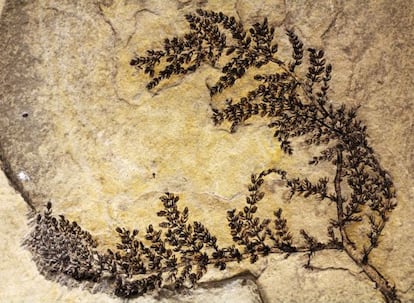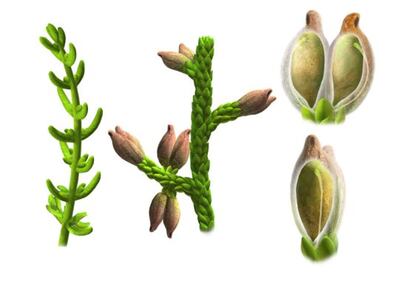Planet’s first flower bloomed in Spain 130 million years ago
‘Montsechia’ grew in what are now parts of Cuenca and Lleida, researchers find

Around 130 million years ago what are today two mountainous areas of northeastern Spain, the Sierra del Montsec in Lleida province and the Serranía de Cuenca, were lowlands filled with lakes. And it was within these lakes that the first flowering plant on earth appeared, and that scientists have named Montsechia vidallii, after the Montsec range.
The first fossilized Montsechia flowers were found more than 200 years ago, but had been ignored by scientists
The first fossilized Montsechia flowers were found more than 200 years ago, but had been ignored by scientists, who mistakenly identified them as lichen, moss or even distant relatives of the pine. But after laborious work using the latest microscope technology, a team of US, Spanish and French researchers have established the true importance of Montsechia as the first angiosperm, or flowering plant.
“Montsechia is the oldest angiosperm ever found in fossilized form that includes the plant part – stem and leaves – together with its flower: fruits and seeds,” says Bernard Gomez, a French paleo-botanist at the University of Lyon, and a co-author of the study, which was published in the Proceedings of the National Academy of Sciences.
Angiosperms dominate the earth’s vegetable cover, to such an extent that Charles Darwin defined their explosive propagation as “an abominable mystery.” An angiosperm is organized into stems and leaves, and has vascular tissue, which allows it to transport resources internally. It also produces seeds. But the key identifier is its intricate reproduction system within the flower, which is made up of petals, sepals, carpel and stamen.

“People think that flowers are large, with different colored petals, carpels and stems,” says Gomez. “But the flower is a reproductive organ if it has a carpel and a stamen. Montsechia meets the requirement of having a carpel,” he adds. And it is here, in this female enclosed leaf that the ovary is to be found. “Some scientists say flower evolution went through a phase without sepals, petals or nectar. This is what we see with the Montsechia, which makes it the oldest flowering plant we know of so far,” he adds.
The team discovered the plant’s seeds by separating fossilized stems and leaves using minute drops of hydrochloric acid. The cuticle, or plant epidermis, was obtained by applying a mixture of nitric acid and potassium chlorate. The samples were then examined under an electron microscope.
The team has also been able to confirm the sub-aquatic nature of the plant, which would have been eaten by dinosaurs such as the iguanodon, and had no roots, although it spent its life on the bottom of a lake. The researchers were unable to find any pollen from the plant, and they suggest that it reproduced through hydrophily, or by using the water it was immersed in to pollinate, in the same way that other plants use the air or insects.
Tu suscripción se está usando en otro dispositivo
¿Quieres añadir otro usuario a tu suscripción?
Si continúas leyendo en este dispositivo, no se podrá leer en el otro.
FlechaTu suscripción se está usando en otro dispositivo y solo puedes acceder a EL PAÍS desde un dispositivo a la vez.
Si quieres compartir tu cuenta, cambia tu suscripción a la modalidad Premium, así podrás añadir otro usuario. Cada uno accederá con su propia cuenta de email, lo que os permitirá personalizar vuestra experiencia en EL PAÍS.
¿Tienes una suscripción de empresa? Accede aquí para contratar más cuentas.
En el caso de no saber quién está usando tu cuenta, te recomendamos cambiar tu contraseña aquí.
Si decides continuar compartiendo tu cuenta, este mensaje se mostrará en tu dispositivo y en el de la otra persona que está usando tu cuenta de forma indefinida, afectando a tu experiencia de lectura. Puedes consultar aquí los términos y condiciones de la suscripción digital.
Últimas noticias
Most viewed
- Alain Aspect, Nobel laureate in physics: ‘Einstein was so smart that he would have had to recognize quantum entanglement’
- Maps of the US attack on Venezuela: Targets, airspace and deployed fleet
- Key points of the military attack on Venezuela: Early morning bombings and a ‘captured’ president
- Oil, gold and rare earth elements: the backdrop to US political tension with Venezuela
- The US bombing of Venezuela, in pictures









































